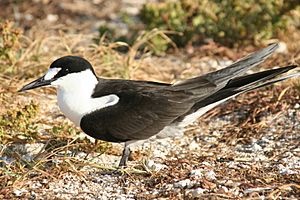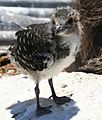Sooty tern facts for kids
Quick facts for kids Sooty tern |
|
|---|---|
 |
|
| Onychoprion fuscatus nubilosus (or O. f. oahuensis) on Tern Island (French Frigate Shoals) | |
| Conservation status | |
| Scientific classification | |
| Genus: |
Onychoprion
|
| Species: |
fuscatus
|
| Subspecies | |
|
2-9, see text |
|
 |
|
| Synonyms | |
|
Onychoprion fuscata (lapsus) |
|
The sooty tern (Onychoprion fuscatus) is a type of seabird. It belongs to the Laridae family. These birds live in warm, tropical oceans. They are amazing because they can sleep while flying! Sooty terns only come back to land to lay their eggs and raise their young. They do this on islands near the equator.
Contents
Sooty Tern: What's in a Name?
How the Sooty Tern Got Its Scientific Name
The sooty tern was first described by a scientist named Carl Linnaeus in 1766. He called it Sterna fuscata. For many years, this was its official name. Later, scientists decided to split the Sterna group into smaller parts. Now, the sooty tern is known as Onychoprion fuscatus.
The first part of its new name, Onychoprion, comes from ancient Greek words. Onux means "claw" or "nail," and prion means "saw." The second part, fuscatus, is a Latin word meaning "dark." This name fits the bird's dark feathers.
Other Names for the Sooty Tern
People often call the sooty tern the "wideawake tern." This name comes from the loud, constant calls that a group of these birds makes. Imagine a whole colony of them calling out!
In the Hawaiian language, it's called ʻewa ʻewa. This name also means something like "loud noise" or "cacophony."
In most parts of Polynesia, it's known as manutara. This means "tern-bird." It's like saying "the common tern." This name shows how important these birds were. Wherever Polynesian sailors traveled on their long trips, they would often find many sooty terns.
On the Marquesas Islands, it's called kaveka. People there enjoy dishes made with its eggs.
Sooty Tern Subspecies
Even though sooty terns look quite similar everywhere, scientists divide them into different groups. These groups are called subspecies. They live in different areas around the world.
There are at least two main subspecies. Some scientists think there might be up to eight different types, especially in the Indopacific region.
- Onychoprion fuscatus fuscatus (Linnaeus, 1766) – This is the Atlantic sooty tern. It has white feathers on its belly. It breeds in the Atlantic and Caribbean areas.
- Onychoprion fuscatus nubilosus (Sparrman, 1788) – This is the Indopacific sooty tern. Its belly feathers are light grey when new. They turn dull white when they get older. This subspecies breeds from the Red Sea across the Indian Ocean to the central Pacific.
Sooty Tern: What It Looks Like


The sooty tern is a large bird. It is about 33–36 cm (13–14 in) long. Its wings can spread out to 82–94 cm (32.5–37 in). It has long wings and a tail that is deeply forked, like a "V."
Its upper body is dark black, and its belly is white. It has black legs and a black beak. On average, a sooty tern lives for about 32 years. Young sooty terns look a bit different. They have scaly grey feathers on both their top and bottom.
It's hard to confuse the sooty tern with other birds. The only one that looks similar is the bridled tern (O. anaethetus), which is smaller. The sooty tern has a darker back than the bridled tern. It also has a wider white area on its forehead and no pale collar around its neck.
The call of the sooty tern is very loud and sharp. It sounds like ker-wack-a-wack or kvaark.
Sooty Tern: Its Life and Habits

Sooty terns gather in large groups called colonies to breed. They choose rocky or coral islands for their nesting sites. They make a simple nest, which is just a scrape or a small hole on the ground. The female bird lays one to three eggs.
These birds eat fish that they catch from the ocean surface. They often hunt in large groups. Sooty terns spend most of their lives at sea. They rarely come to land except to breed. Some can stay out at sea for 3 to 10 years without touching land! This is because their feathers do not have much oil. This means they cannot float on the water. So, they spend all that time flying.
Sooty terns are migratory birds. This means they travel to different places depending on the season. They spread out widely across the tropical oceans during winter. They are very much ocean birds. You usually only find sooty terns inland if there has been a very bad storm. For example, one sooty tern was found far inland in Africa after a storm.
These birds are not usually seen on the Pacific coasts of the Americas. This is because they prefer the open ocean. However, you might see them more often near Baja California. This is because some of their nesting places are offshore there.
The sooty tern is a very common bird. The IUCN says it is not in danger of disappearing.
Sooty Tern: Role in Easter Island Culture
On Easter Island, the sooty tern and the spectacled tern (O. lunatus) are both called manutara. The manutara birds were very important in an old tradition called the tangata manu ritual. Tangata manu means "birdman."
In this ritual, a champion, called a hopu, had to swim to a small island called Motu Nui. The first hopu to bring back a manutara egg would become that year's tangata manu. This "birdman" and his clan would then get special access to important resources. These resources included seabird eggs.
Gallery
-
Sooty tern rookery on Tern Island (French Frigate Shoals)
-
Sooty tern chicks seeking shade under the shadow of a young black-footed albatross
-
A chick is snatched by a predatory great frigatebird
See also
 In Spanish: Charrán sombrío para niños
In Spanish: Charrán sombrío para niños








